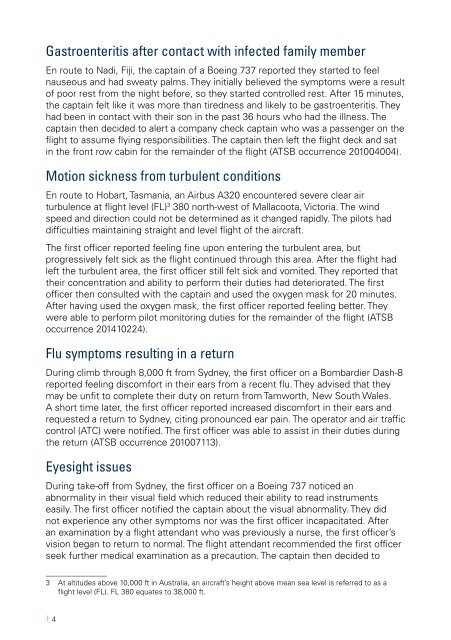Pilot incapacitation occurrences 2010–2014
8rKXy6YKY
8rKXy6YKY
Create successful ePaper yourself
Turn your PDF publications into a flip-book with our unique Google optimized e-Paper software.
Gastroenteritis after contact with infected family member<br />
En route to Nadi, Fiji, the captain of a Boeing 737 reported they started to feel<br />
nauseous and had sweaty palms. They initially believed the symptoms were a result<br />
of poor rest from the night before, so they started controlled rest. After 15 minutes,<br />
the captain felt like it was more than tiredness and likely to be gastroenteritis. They<br />
had been in contact with their son in the past 36 hours who had the illness. The<br />
captain then decided to alert a company check captain who was a passenger on the<br />
flight to assume flying responsibilities. The captain then left the flight deck and sat<br />
in the front row cabin for the remainder of the flight (ATSB occurrence 201004004).<br />
Motion sickness from turbulent conditions<br />
En route to Hobart, Tasmania, an Airbus A320 encountered severe clear air<br />
turbulence at flight level (FL) 3 380 north-west of Mallacoota, Victoria. The wind<br />
speed and direction could not be determined as it changed rapidly. The pilots had<br />
difficulties maintaining straight and level flight of the aircraft.<br />
The first officer reported feeling fine upon entering the turbulent area, but<br />
progressively felt sick as the flight continued through this area. After the flight had<br />
left the turbulent area, the first officer still felt sick and vomited. They reported that<br />
their concentration and ability to perform their duties had deteriorated. The first<br />
officer then consulted with the captain and used the oxygen mask for 20 minutes.<br />
After having used the oxygen mask, the first officer reported feeling better. They<br />
were able to perform pilot monitoring duties for the remainder of the flight (ATSB<br />
occurrence 201410224).<br />
Flu symptoms resulting in a return<br />
During climb through 8,000 ft from Sydney, the first officer on a Bombardier Dash-8<br />
reported feeling discomfort in their ears from a recent flu. They advised that they<br />
may be unfit to complete their duty on return from Tamworth, New South Wales.<br />
A short time later, the first officer reported increased discomfort in their ears and<br />
requested a return to Sydney, citing pronounced ear pain. The operator and air traffic<br />
control (ATC) were notified. The first officer was able to assist in their duties during<br />
the return (ATSB occurrence 201007113).<br />
Eyesight issues<br />
During take-off from Sydney, the first officer on a Boeing 737 noticed an<br />
abnormality in their visual field which reduced their ability to read instruments<br />
easily. The first officer notified the captain about the visual abnormality. They did<br />
not experience any other symptoms nor was the first officer incapacitated. After<br />
an examination by a flight attendant who was previously a nurse, the first officer’s<br />
vision began to return to normal. The flight attendant recommended the first officer<br />
seek further medical examination as a precaution. The captain then decided to<br />
3 At altitudes above 10,000 ft in Australia, an aircraft’s height above mean sea level is referred to as a<br />
flight level (FL). FL 380 equates to 38,000 ft.<br />
› 4


